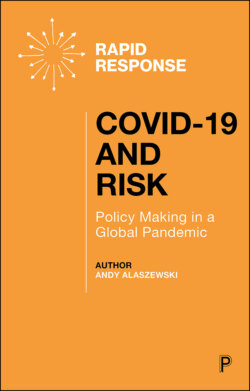Читать книгу COVID-19 and Risk - Alaszewski Andy - Страница 9
На сайте Литреса книга снята с продажи.
Preface
ОглавлениеThis book developed out of my interest in risk. Since the mid-1990s, I have researched, published and edited an international journal on risk (Health, Risk and Society).
In 2008, I was invited to join the UK Scientific Advisory Group on Pandemic Influenza (SPI) convened by the Department of Health, a precursor of the current scientific advisory groups on pandemics. In the committee, we reviewed the risk of a global flu pandemic impacting on the UK (high) and considered the effectiveness of alternative responses (probably limited). The three groups of experts on the committee each advocated a different approach to mitigating the risk of a pandemic:
• Scientists with expertise in microbiology or pharmacy supported the development of vaccines to prevent infection or mitigate symptoms. This was problematic as flu and other viruses tend to mutate rapidly so flu vaccines have limited efficacy.
• Behavioural scientists advocated behavioural changes to improve personal hygiene such as hand washing and sneezing into disposable tissues. It was not clear how easy it would be to improve personal hygiene nor how effective it would be in limiting the spread of a highly infectious virus.
• Epidemiologists and risk experts including me focused more on evidence from past pandemics, especially the 1918–19 Spanish flu pandemic. In the US, those cities which shut down quickly and stayed shut down the longest had the lowest death rates whereas those cities that delayed shutting down and reopened quite quickly had the highest death rate. During a pandemic, a global spread of a deadly disease, it was probable that the virus causing the disease would be carried into the UK by international travellers and then distributed by public transport systems and large-scale gatherings. The only way to control its spread was by limiting access through ports and airports and reducing social interactions on public transport and at large public events, an approach that is now referred to as social distancing. In such a pandemic, it would be imperative that the public were warned, especially the most vulnerable such as the elderly, so they could take action to protect themselves.
The civil servants who serviced the committee were unreceptive to the social distancing approach. They felt it would infringe on civil liberties and disrupt economic activity. They were more receptive to approaches that focused on individuals: vaccination and personal hygiene, such as hand washing and nose blowing.
Like most people in Europe, I first became aware of COVID-19 in early 2020. My wife Helen’s brother was admitted to a major teaching hospital in Paris in February 2020 with advanced kidney cancer. Through February into early March, we visited him regularly and were able to observe the French adopt a policy of social distancing. When we returned to England in early March, I was shocked at the lack of action. Despite media reports that there were virus hotspots in Northern Italy and central Spain and that the virus was rapidly spreading in Europe, no efforts were made in the UK to restrict or monitor travellers from virus hotspots nor to restrict large public gatherings. I found it difficult to see why governments in Europe were so slow to react, given that the warning signs were there from mid-January. This stimulated my interest in the pandemic and is one reason why I wrote this book.
Another stimulus came a couple of weeks later. On 16 March, I was listening to the 6 o’clock news on BBC Radio 4 and I heard an extract from the Downing Street press briefing. The Prime Minister announced the British response to COVID-19 was shifting to a lockdown of social and economic activity. At this briefing, the Chief Medical Officer, Chris Whitty, identified a number of groups who were at high risk and should protect themselves, including pregnant women. I was puzzled as pregnant women were the only group of people in the high-risk category for whom there was no evidence that they were particularly vulnerable to COVID-19. My daughter, Anna, who lived in New York, had heard the same interview and phoned me to talk about it. To be sure that I understood what Chris Whitty had said, I watched the briefing on YouTube. I was able to reassure Anna that there was no evidence that she or her unborn baby were especially vulnerable to COVID-19 and it was a precautionary measure. However, I was curious why the precautionary principle of ‘better safe than sorry’ was being used to include pregnant women in the high-risk category.
In this book, I explore these issues and consider the role which risk has played in the ways policy makers round the world have responded to the risks of COVID-19.
Andy Alaszewski, Canterbury, Kent
January 2021
